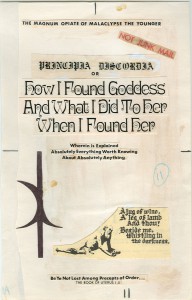
One of Discordianism’s two founders, Kerry Thornley, famously declared that if ‘religion is the opium of the masses, [then] Discordianism is the marijuana of the lunatic fringe,’ and this is made nowhere more clear than in its material culture over the last fifty-six years.2 The majority of Discordianism’s material culture has been comprised of self-published work in the form of religious certificates, ‘zines’, APAs (amateur press associations), live audio recordings of Robert Anton Wilson lectures, and, with the advent of the internet, BBSes (Bulletin Board System), PFDs, and blogs.3 The paper ephemera of Discordianism’s material history has not been catalogued by libraries, nor preserved by universities, but commonly remains in the possession of its initial recipients, or forgotten in the boxes that compose private zine archives. Lacking any familiarity with this ‘underground’ material, scholarly analysis of the mass-marketed Discordian texts, and Discordianism in toto, has been altogether superficial.

The second issue concerns the lack of scholarly convention concerning which version of the Principia is regarded as authoritative. As a result of the 4th edition Principia’s ‘copyleft,’ or anti-copyright status, there are no less than five different published versions of the 4th/5th edition, in addition to innumerable online versions. While there is not a great deal of difference between versions, scholarly neglect of this point, as well as the lack of convention concerning which version of the 4th/5th edition of the Principia should be treated as authoritative, has instilled an unnecessary amount of irregularity into the study of Discordianism.6
The third issue is partly based on the first, but regards a more general misinterpretation of the meaning of the Principia within the Discordian milieu. Scholars regard the 4th/5th edition of the text as the central Discordian holy work, and it is not hard to understand why; it seems to offer all of the requisite data for a normative appraisal of a religious movement. It contains an origin story for the religion, a list of commandments, a liturgical calendar, a list of saints, and an account of Discordianism’s principle deity, Eris. In sum, the 4th/5th edition of the Principia seems to be a perfect index of everything a ‘real’ religion needs. This, of course, is precisely the problem. Leaving aside the fact that many of the aforementioned ‘religious’ aspects of Discordianism were added in successive editions of the Principia, the primary issue here is that Discordianism is explicitly not based on liturgical observance or orthopraxis, but rather on the utilization of beliefs as heuristic tools. Scholarly preoccupation with the religious minutia contained in the Principia evidences that scholars have missed an essential aspect of the Discordian ludibrium.
Since the various publications of the 4th and 4th/5th editions of the Principia read like conventional holy texts, or at least as a parody of one, scholars have mistakenly taken it as the text that has governed Discordianism since its inception. While some contemporary Discordians may revere it as such, familiarity with previous editions of the text, let alone the history of Discordianism, make it clear that this was not always the case. Discordianism did not reach underground audiences until nearly two decades after it was founded, and even then it was not an edition of the Principia that publicized the religion, but a trilogy of novels. Despite having numerous quotes from the Principia, the fictitious nature of Robert Anton Wilson and Robert Shea’s Illuminatus! trilogy (1975) of novels led many to believe that the Principia did not actually exist á la Lovecraft’s Necronomicon. Needless to say, Discordianism’s underground popularization was not based on teachings outlined in the first, second, third, or fourth editions of the Principia, but Wilson and Shea’s interpretation of them in Illuminatus! The first widely popular edition of the Principia was published nearly five years after Illuminatus! as a result of Loompanics publisher Mike Hoy reading the trilogy, and querying Hill himself as to the existence of such a text.7 The shift to institutionalization in contemporary Discordianism has led to the formalization of Discordian beliefs, and, central to this has been the reframing of the Principia as foundational to the religion. The scholarly preoccupation with the contents of the Principia illustrates the way in which scholars’ research agendas owe more to the contemporary trend towards institutionalization within the religion than rigorous historical research on it.
Read in terms of its evolution and alongside other Discordian material, it is evident that the various editions of the Principia were never merely parodies of sacred texts, nor were they strictly genuine attempts to fashion one. Instead, they were iterations of an idiosyncratic form of genre appropriation based on the conviction that all beliefs are heuristic tools for creating models of reality. Said more precisely, the various editions of the Principia were not just satire, but prime examples of the assiduous playing with religious forms that epitomizes Discordian belief. Essentially, this type of humorous play functions as the liturgical language of Discordianism. Reflecting William Burroughs’s famous adage, ‘nothing is true and everything is permitted,’ Discordianism is a meta-belief system in which abstract concepts like ‘holy scripture’ are utilized as expedient means to destabilize fixed assumptions about reality. Though more salient in later editions, the Principia appropriated the genre of sacred scripture in the same way that Camden Benares’ Discordian treatise, Zen Without Zen Masters (1977), utilizes tropes associated with Zen koan books, and the same is true for the appropriation of conspiracy theory in Wilson and Shea’s Illuminatus! trilogy. Discordian texts have taken the form of science fiction epics, historical dramas, anarchist philosophy, psychologized-occult manuals, and Zen teachings, and regardless of their form, the dynamics of these genre appropriations are the same. Discordian authors appropriate genre conventions only to exploit their ability to communicate the central metaphysical truth of their religion, namely, that the experience of reality entirely depends on the belief system, or model through which it is comprehended.8
Christian Greer is a PhD researcher in the field of Western esotericism at the University of Amsterdam. His primary focus is the history and material culture of Discordianism, the Church of the SubGenius and the Moorish Orthodox Church, particularly in the 1980-1990s. His dissertation, Angelheaded Hipsters: From Beatnik Antinomianism to Psychedelic Millenarianism is an intellectual history of the “counterculture” beginning with the revolutionary movements of the 1960s and ending in the 1990s with cyberpunk and fin de siècle cyberculture.
https://uva.academia.edu/ChristianGreer
1 For a more detailed analysis of this problem in the work of one scholar, see Greer, Christian. ‘Review of Carole M. Cusack’s Invented Religions: Imagination, Fiction and Faith,’ Correspondences 2.1 (2014), pp. 109–114.
2 Thornley, Kerry. ‘Introduction’ in Principia Discordia 4th/5th edition, Lilburn, GA; Illuminet Press, 1991, p.i.
3 See Greer, ‘Occult Origins’, pp. 166-187.
4 The Loompanics edition (1979) is known as the ‘4th/5th edition’ because it reprinted the original 4th edition published by Rip Off Press in 1970, as well as the 5th edition, which was nothing more than a Western Union telegram filled with the letter ‘M’. The Loompanics version is most likely considered authoritative on account of it being the first to include the 5th edition telegram, as well as material that was not included in previous editions, e.g. ‘the Gypsie Skrypto interview,’ and an introduction by Robert Anton Wilson. For a more comprehensive overview of the publishing history of the Principia Discordia see Gorightly, Adam. ‘Adam Gorightly on the Publishing History of the Principia Discordia’ https://www.youtube.com/watch?v=bUqVrH4luXc accessed 04/05/13; see also f.8.
5 Cusack’s Invented Religion (2010) exemplifies this error insofar as her familiarity with the Principia Discordia is limited to two mass marketed 4th/5th editions of the text, which bear little resemblance to the first edition produced decades earlier. This is made obvious by the fact that she seems unaware that the first edition had a different title as well as entirely different contents. See Cusack, Carole. Invented Religions: Imagination, Fiction and Faith, Farnham: Ashgate, 2010, p.28-29 as compared to the first edition reproduced in Gorightly, Adam. Historia Discordia: The Origins of the Discordian Society. New York: RVP Press, 2014, pp.25-80. Cusack is by no means the only scholar to make this mistake, indeed, the difference between editions of the Principia has not been noticed within any notable study of Discordianism; see also Urban, Hugh. Magia Sexualis: Sex, Magic, Liberation in Modern Western Esotericism. Berkeley: University of California Press, 2006, p. 233-235; Versluis, Arthur. American Gurus: From Transcendentalism to New Age Religion. New York: Oxford University Press, 2014, p.123-138.
6 The three most important academic texts on Discordianism have all used different versions of the 4th/5th edition of the Principia: Cusack cites the Steve Jackson Games version in Invented Religion (2010), Urban references the Loompanics version in Magia Sexualis (2006), and Versluis based his work in American Gurus (2014) on the Illuminet edition.
7 The earliest version of the popular Loompanics edition of the Principia was published in 1979, and it featured an introduction by Hoy. This version was superseded by the popular 1980 edition, which contained Wilson’s introduction. See Gorightly, ‘Adam Gorightly on the Publishing History of the Principia Discordia’.
8 Wilson refers to the means by which an individual can ‘meta-program’ their own reality as the ‘final secret of the Illuminati’. See Wilson, Robert A. Cosmic Trigger: Final Secret of the Illuminati Vol.1, Tempe, AZ.: New Falcon Publications, 1997, pp.29, 68-71.
5 replies on “The State of the Art of Research on Discordianism by Christian Greer”
Excellent article! While I’ve been a member of the Church of the SubGenius (I grew out of it, thank goodness), Discordianism, and the Moorish Orthodox Church, I was also a religious studies major (with a degree in “Comparative Mysticism as Embodied by Religion, Philosophy, and Art” through the New College at the U of Alabama). I have noticed that Discordianism has been getting scholarly treatment, especially in the “New Religions” field, but have not yet delved into it. Ironically, I did just order Carole M. Cusack’s Invented Religions: Imagination, Fiction and Faith, as the description of the book sounded like the author understood that Discordianism was not merely a parody religion. I’m hoping Prof. Greer’s dissertation is available, as he certainly seems to know this area.
I was also quite impressed to see Discordianism described as a “ludibrium,” which may be a word missed on those who are not students of Western Esotericism. It was famously (well, in the field of Western Esotericism) used by Johann Andreae to describe the Rosicrucian manifestos (which he most likely had a part in) after the Chaos they stirred up. The best scholars on this subject (IMHO) explain that ludibrium to him meant a “jest” or “sport,” but a serious jest. Besides Francis Yates’ classic The Rosicrucian Enlightenment, there is a great (though very academic, not for the beginner) article by Thomas Willard, “Andreae’s ludibrium: Menippean Satire in the Chymische Hochzeit” in Laughter in the Middle Ages and Early Modern Times edited by Albrecht Classen. I’ve always thought that ludibrium was a great word to describe the ethos of Erisianism, I’m glad someone with proper academic credentials (and real knowledge) thinks the same!
Very good article. Adam, have you told Christian about the re-discovery of the ODD#s (Official Discordian Document Numbers)?
Telarus, just the other day I came across some more info on ODD#s….I will send it for you to check out….Maybe you could do a write up on the subject we could post here? Not sure if I still have your email address. Maybe you could send it to me at adamgorightly@yahoo.com
the difference between editions of the Principia has not been noticed within any notable study of Discordianism
Hey…
Thisis wonnderfl